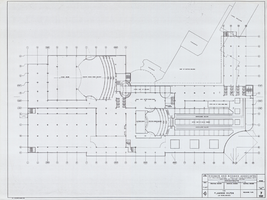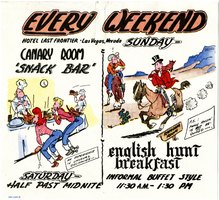Search the Special Collections and Archives Portal
Search Results

Architectural drawing of the Flamingo Hilton tower addition (Las Vegas), mezzanine plan, November 4, 1975
Date
Archival Collection
Description
Architectural plans for the addition of a tower to the Flamingo in 1976. Printed on parchment. Socoloske, Zelner and Associates, structural engineers; Harold L. Epstein and Associates, structural engineers; Bennett/Tepper, mechanical engineers; J. L. Cusick and Associates, electrical engineers.
Site Name: Flamingo Hotel and Casino
Address: 3555 Las Vegas Boulevard South
Image

Architectural drawing of the Flamingo Hilton tower addition (Las Vegas), second floor plan, November 4, 1976
Date
Archival Collection
Description
Architectural plans for the addition of a tower to the Flamingo in 1976. Printed on parchment. Socoloske, Zelner and Associates, structural engineers; Harold L. Epstein and Associates, structural engineers; Bennett/Tepper, mechanical engineers; J. L. Cusick and Associates, electrical engineers.
Site Name: Flamingo Hotel and Casino
Address: 3555 Las Vegas Boulevard South
Image

Hotel Last Frontier, advertisement, circa 1950
Date
Description
Image
Cork Proctor Papers
Identifier
Abstract
The Cork Proctor Papers document the career of comedian Cork Proctor from 1942 to 2012. The papers include photographs, programs, advertisements, and newspaper articles that illustrate both the longevity and influence of one of Nevada's most famous comedians. From 1972 to 2012, in both Reno and Las Vegas, Proctor consistently worked as a stand-up comedian, writer, and roaster.
Archival Collection
Fercos Family Publicity Collection
Identifier
Abstract
The Fercos Family Publicity Collection (approximately 1978-1989) contains newspaper articles, advertisements, and a poster promoting the Flying Fercos, a family of juggling and acrobatic performers who performed in Las Vegas, Nevada at the Dunes Hotel during the 1970s and 1980s. The materials document the Fercos family's act as part of producer Frederic Apcar's shows such as
Archival Collection
Jean Hertzman Menu Collection
Identifier
Abstract
The Jean Hertzman Menu Collection (1970s-2000s) consists primarily of menus from Las Vegas, Nevada restaurants including several from casinos that are no longer in operation such as the Silver Slipper, the Thunderbird, and the Sahara. The collection also includes international menus, catering information for various Las Vegas casinos, a Los Angeles, California menu guidebook, and a corporate information packet for MGM Resorts International.
Archival Collection
Herman van Betten Papers
Identifier
Abstract
The Herman van Betten Papers contain correspondence, campaign fliers, photographs, conference papers, and newspaper articles regarding his involvement in education, mental health matters, regional planning, and political issues in Nevada.
Archival Collection
Norman C. Jensen Collection
Identifier
Abstract
The Norman C. Jensen Collection, dated from 1867 to 1968, contains documents discovered by Norman C. Jensen at Fort Taylor, Florida. The collection includes a copy of the "Report of a Guard Mounted at Fort Jefferson, Florida on May 28, 1867" that describes four individuals accused of conspiracy in connection with the assassination of President Abraham Lincoln. The collection also contains an original report entitled "Quarterly Report of Artillery Inspection of Fort Taylor, Florida" dated December 31, 1903, and Lt. Col. Jensen's notes explaining the military abbreviations contained within the original report.
Archival Collection
Nevada Poetry Society Records
Identifier
Abstract
The Nevada Poetry Society Records are comprised of the Society's records dating from 1961 to 1973. Society organizer and president, Mildred Breedlove is featured prominently in the collection. Materials include Silver Strings: Nevada Poetry Society Anthology, a collection of poems commemorating Nevada's centennial year, individual poems from members, financial records, correspondence, and newsletters.
Archival Collection
Gwendolyn Woolley Photographs
Identifier
Abstract
The Gwendolyn Woolley Photographs contain photographs from Las Vegas, Nevada from approximately 1934 to 1953. The photographs primarily depict students at the Junior Prom at Las Vegas High School in 1953. The photographs also depict members of the Ladies Society of Brotherhood of Firemen and Locomotive Engineers at the first Helldorado Parade in Las Vegas, Nevada.
Archival Collection
